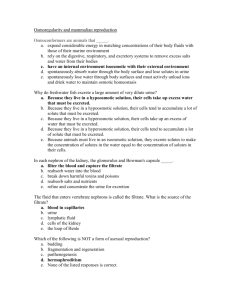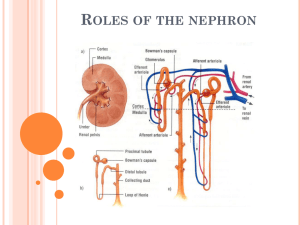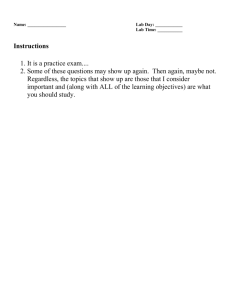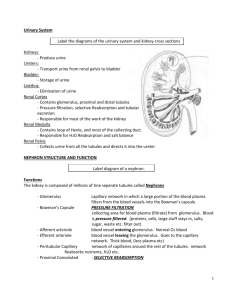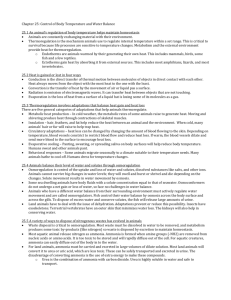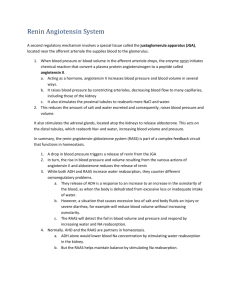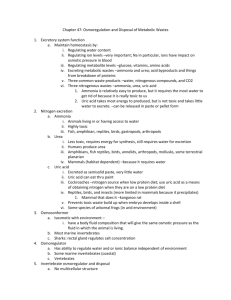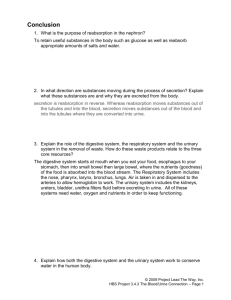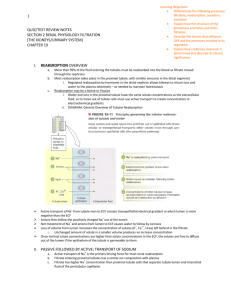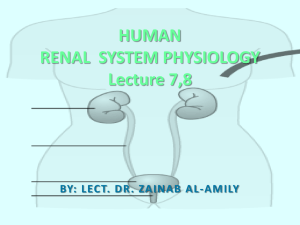Instructor`s Answer Key
advertisement
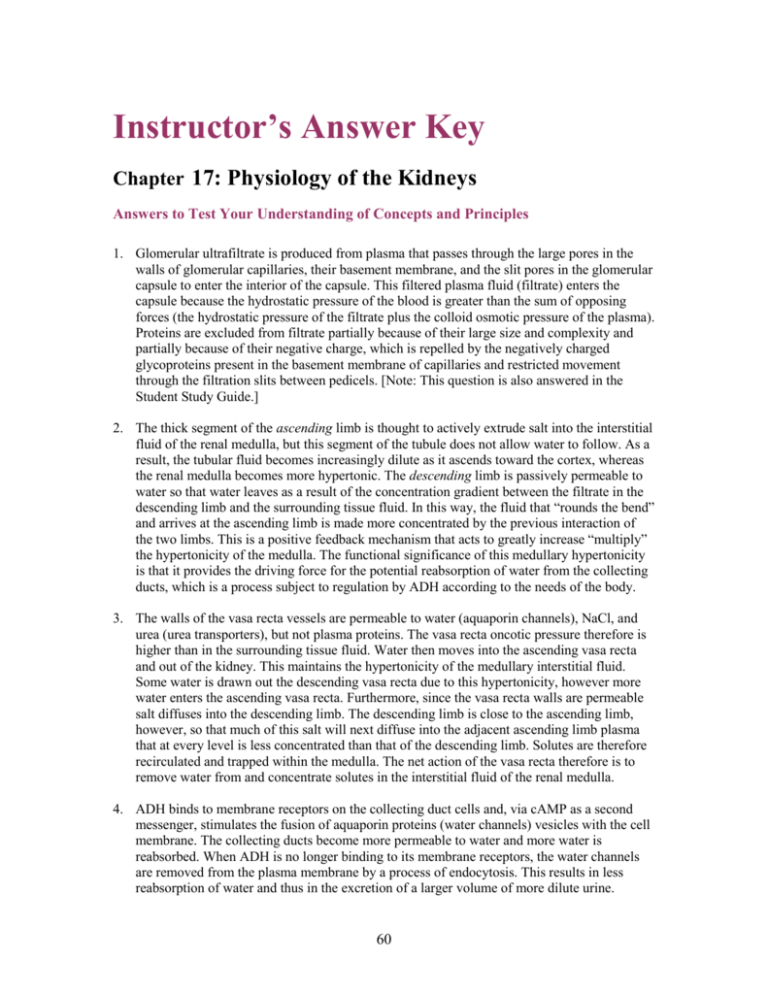
Instructor’s Answer Key Chapter 17: Physiology of the Kidneys Answers to Test Your Understanding of Concepts and Principles 1. Glomerular ultrafiltrate is produced from plasma that passes through the large pores in the walls of glomerular capillaries, their basement membrane, and the slit pores in the glomerular capsule to enter the interior of the capsule. This filtered plasma fluid (filtrate) enters the capsule because the hydrostatic pressure of the blood is greater than the sum of opposing forces (the hydrostatic pressure of the filtrate plus the colloid osmotic pressure of the plasma). Proteins are excluded from filtrate partially because of their large size and complexity and partially because of their negative charge, which is repelled by the negatively charged glycoproteins present in the basement membrane of capillaries and restricted movement through the filtration slits between pedicels. [Note: This question is also answered in the Student Study Guide.] 2. The thick segment of the ascending limb is thought to actively extrude salt into the interstitial fluid of the renal medulla, but this segment of the tubule does not allow water to follow. As a result, the tubular fluid becomes increasingly dilute as it ascends toward the cortex, whereas the renal medulla becomes more hypertonic. The descending limb is passively permeable to water so that water leaves as a result of the concentration gradient between the filtrate in the descending limb and the surrounding tissue fluid. In this way, the fluid that “rounds the bend” and arrives at the ascending limb is made more concentrated by the previous interaction of the two limbs. This is a positive feedback mechanism that acts to greatly increase “multiply” the hypertonicity of the medulla. The functional significance of this medullary hypertonicity is that it provides the driving force for the potential reabsorption of water from the collecting ducts, which is a process subject to regulation by ADH according to the needs of the body. 3. The walls of the vasa recta vessels are permeable to water (aquaporin channels), NaCl, and urea (urea transporters), but not plasma proteins. The vasa recta oncotic pressure therefore is higher than in the surrounding tissue fluid. Water then moves into the ascending vasa recta and out of the kidney. This maintains the hypertonicity of the medullary interstitial fluid. Some water is drawn out the descending vasa recta due to this hypertonicity, however more water enters the ascending vasa recta. Furthermore, since the vasa recta walls are permeable salt diffuses into the descending limb. The descending limb is close to the ascending limb, however, so that much of this salt will next diffuse into the adjacent ascending limb plasma that at every level is less concentrated than that of the descending limb. Solutes are therefore recirculated and trapped within the medulla. The net action of the vasa recta therefore is to remove water from and concentrate solutes in the interstitial fluid of the renal medulla. 4. ADH binds to membrane receptors on the collecting duct cells and, via cAMP as a second messenger, stimulates the fusion of aquaporin proteins (water channels) vesicles with the cell membrane. The collecting ducts become more permeable to water and more water is reabsorbed. When ADH is no longer binding to its membrane receptors, the water channels are removed from the plasma membrane by a process of endocytosis. This results in less reabsorption of water and thus in the excretion of a larger volume of more dilute urine. 60 5. The side of the proximal convoluted tubule (PCT) cell plasma membrane facing the lumen is the apical side and contains microvilli, which increase the surface area for reabsorption. Adjacent PCT epithelial cells are joined together by tight junctions only at their apical sides so that there are narrow clefts between the sides of adjacent cells that are continuous with the tissue fluid at their basal surfaces where capillaries are located. The basal and lateral sides of the PCT epithelial cell plasma membrane have Na+/K+ pumps. These active transport pumps extrude Na+ from the cytoplasm and into the surrounding tissue fluid, keeping the intracellular Na+ low. The resulting concentration gradient favors the diffusion of Na+ from the tubular fluid across the apical membranes and into the PCT epithelial cells. Chloride ions passively follow sodium ions out of the filtrate and into the interstitial fluid. The accumulation of NaCl raises the osmolality of this interstitial fluid surrounding the PCT and provides a gradient for the reabsorption of water by osmosis. Together, salt and water are reabsorbed from the tubular fluid and can passively enter the peritubular capillary plasma. 6. Thiazide diuretics inhibit water and salt reabsorption through inhibition of sodium transport in the last part of the ascending limb and first segment of the distal convoluted tubule. Loop diuretics act to inhibit active salt transport out of the thick segments of the ascending limb of the loop of Henle. Osmotic diuretics function by increasing the amount of solutes present in the filtrate, which increases the osmotic pressure of the filtrate and decreases the reabsorption of water mainly in the last part of the distal tubule and cortical collecting duct. By increasing the delivery of sodium to the cortical collecting duct, these diuretics can result in the excessive secretion of K+ into the filtrate and its excessive elimination in the urine. 7. Potassium-sparing diuretics block the excessive secretion of K+ into the filtrate and its excessive elimination in the urine. Aldosterone antagonists are one type of potassium-sparing diuretic that competes with aldosterone for cytoplasmic receptor proteins of tubule cells in the last part of the distal tubule and cortical collecting duct. This drug thus blocks the stimulation of Na+ reabsorption and K+ secretion. Another type of potassium-sparing diuretic acts in the same region but more directly to block Na+ reabsorption and K+ secretion. 8. When a person hyperventilates, arterial PCO2 levels decrease and respiratory alkalosis occurs. Consequently, less H+ is secreted into the filtrate. Since the reabsorption of filtered bicarbonate ion requires its recombination with H+ to form carbonic acid, less bicarbonate is reabsorbed. The kidneys thus excrete a larger amount of bicarbonate in the urine that helps to partially compensate for the alkalosis and bring the pH back down to normal. 9. The macula densa is a special group of cells located in the thick portion of the ascending limb where it makes contact with the granular cells of the afferent arteriole – part of the juxtaglomerular apparatus (JGA). The macula densa is the sensor for tubuloglomerular feedback needed for autoregulation of the glomerular filtration rate (GFR). When the filtrate salt and water increases, the macula densa signal the afferent arteriole to constrict, thereby lowering the GFR, and vice versa. In addition, the macula densa signals the granular cells to reduce their secretion of renin when there is increased blood Na+. Thus less angiotensin II is produced and less aldosterone secreted. Less aldosterone means less Na+ reabsorption. As a result, more Na+ (together with Cl- and H2O) is excreted in the urine to help restore homeostasis of blood volume. 61 10. In the nephron, potassium is filtered in the glomerulus, and then ~ 90% is reabsorbed mainly in the PCT. In the late distal tubule and cortical collecting duct, potassium (or H+) is secreted via aldosterone in exchange for Na+ reabsorption – although the transport carrier for Na+ is different than that for K+. The amount of K+ secretion depends on: (1) the amount of Na+ delivered to the late distal tubule and cortical collecting duct; and (2) the amount of aldosterone secreted. If blood K+ rises, aldosterone secretion is stimulated, which in turn, stimulates increased reabsorption Na+ and increased secretion of K+. In the absence of aldosterone, therefore, no K+ is excreted in the urine. All of the K+ in urine is derived from secretion rather than from filtration. Answers to Test Your Ability to Analyze and Apply Your Knowledge 1. The urine sample from the normal patient would have less volume and be more concentrated, whereas the urine sample from the patient with a genetic defect in the urea transporters would have more volume and be more dilute. This results from the genetic lack of urea transporters along the collecting duct of the inner medulla that reduces the amount of urea removed from the nephron filtrate and recirculated into the interstitial space. The increase in urea concentration that remains in the filtrate will have an osmotic pull on the water leading to the greater excretion of both urea and water in the urine. 2. Diabetes insipidus is characterized by an inadequate secretion of or action of ADH resulting in copious amounts of water lost in the urine and dehydration. The man with the stroke developed his diabetes insipidus most likely because the hemorrhage damaged portions of his brain including the supraoptic nuclei region of the hypothalamus, where ADH is produced, and/or, the posterior pituitary, from which ADH is released. Lack of circulating ADH resulted in his diabetes. The other man may have had nephrogenetic diabetes insipidus in which he was born with a genetic defect in the production of aquaporin channels. Lacking these water channels results in very little water reabsorption from the filtrate and his copious diuresis, despite having normal levels of ADH receptors or following exogenous administration of ADH. 3. Polycystic kidney disease is a condition inherited as an autosomal dominant trait on the short arm of chromosome 16. The cysts that develop are expanded portions of the nephron and if the glomerulus were included, would explain the abnormal filtration and the presence of protein in the urine. With an abnormally low glomerular filtration rate (GFR), the creatinine levels would accumulate in the blood. Furthermore, the low GFR was confirmed by injection of inulin and her subsequent abnormally low inulin clearance. Her polycystic disease has progressed and her kidneys are beginning to fail. 4. With the lower half of your body submerged, water pressure is exerted on the lower extremity and thus raises the overall interstitial pressure of the tissues. This rise in pressure is promoting both the return of extracellular fluids to the plasma of tissue capillaries and the return of lymph toward the thoracic cavity and blood of the great veins. The combined increase in capillary and lymph fluid return to the plasma expands the blood volume and raises blood pressure. The rise in blood pressure expands the atrial wall, firing stretch receptors that signal the inhibition of ADH release from the posterior pituitary. Less ADH results in less water reabsorption from the renal tubules and a greater net excretion of water volume in the urine. The increase in urine volume stretches the urinary bladder wall and initiates the micturition reflex with the urge to void. 62 5. Penicillin is one of many antibiotics that are secreted by the renal tubules and thus are rapidly cleared from the blood plasma. Much of the injected penicillin will appear upon urination with the urine odor of “medicine” often reported. In addition, the osmotic effect due the presence of penicillin in the filtrate will increase the osmotic pressure and result in an increase in the excretion of more dilute urine. Vitamin C (ascorbic acid) is a water-soluble vitamin. Ingestion of ascorbic acid provides the blood with organic ascorbate anions that would compete with penicillin for the polyspecific carrier proteins called organic ion transporters, usually located in the basolateral membrane of the proximal tubule. In this way, vitamin C would thus prevent penicillin from being so rapidly secreted and eliminated from the body. 63

